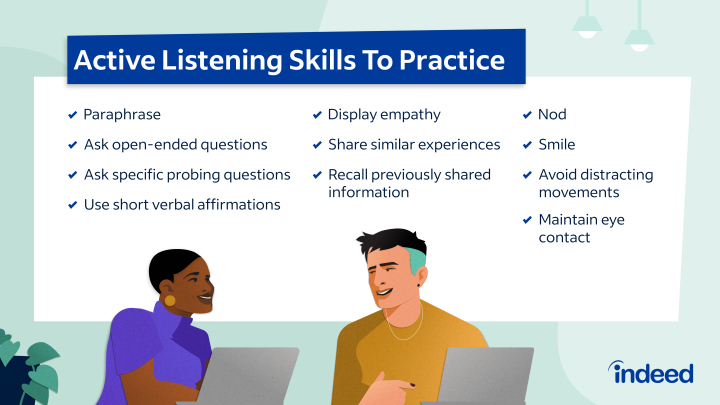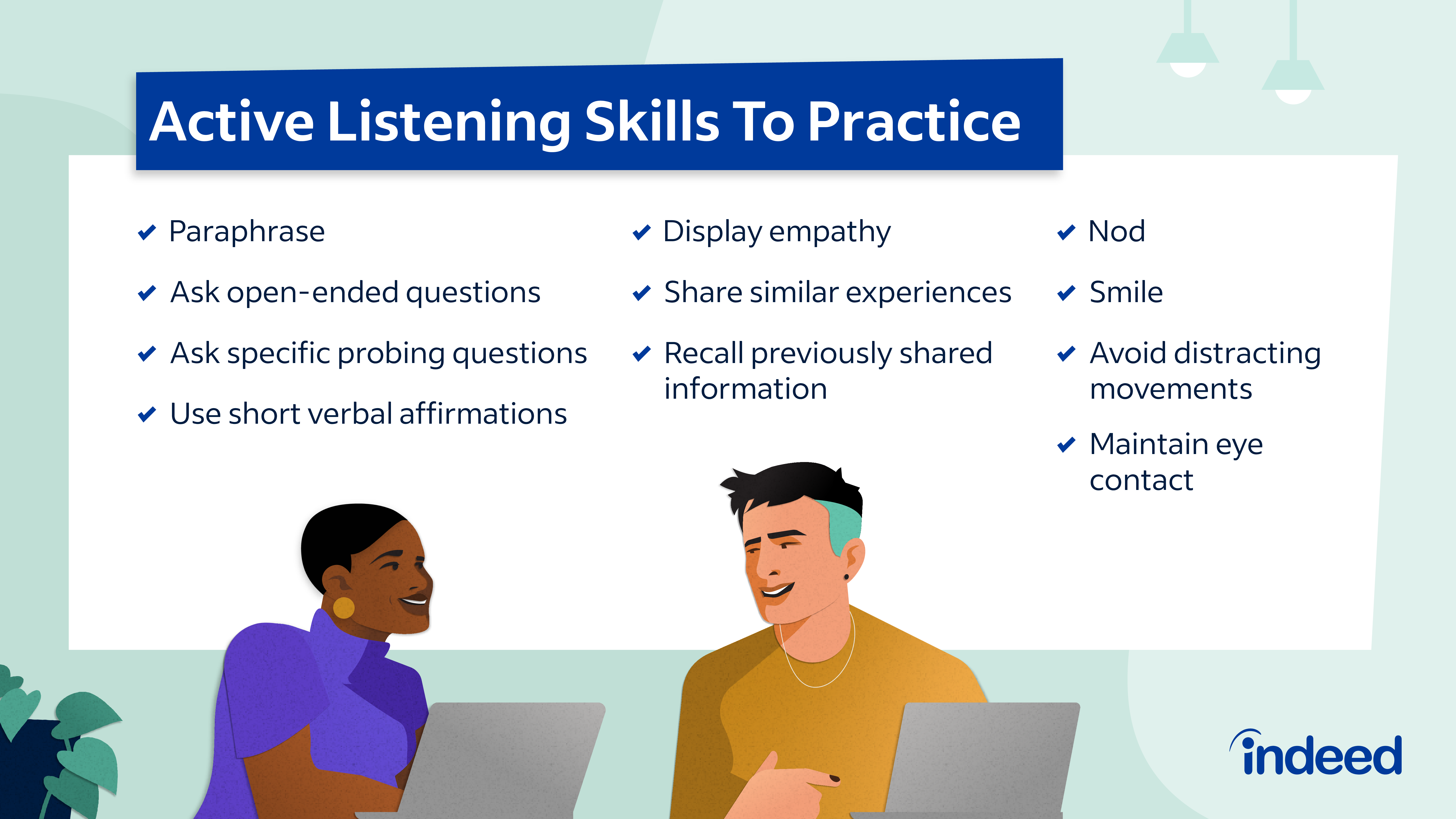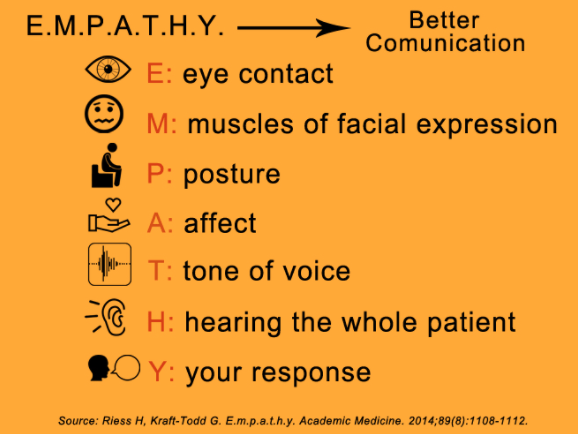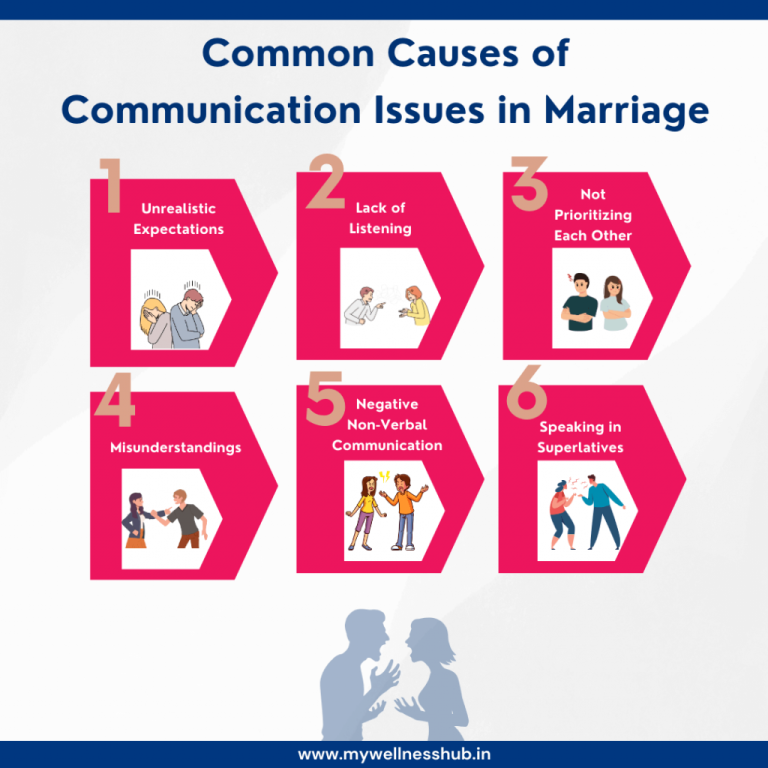Active Listening Skills To Practice
Active listening skills are essential for effective communication, requiring focus and understanding of both verbal and nonverbal cues. Practicing these skills enhances relationships, promotes empathy, and encourages meaningful dialogue.
:max_bytes(150000):strip_icc()/active-listening-skills-with-examples-2059684-ct-edit-b374ca3a973b466283314e6ee3ae7b1a.jpg)
Credit: www.thebalancemoney.com
Understanding Active Listening
Develop your active listening skills by engaging fully in conversations, demonstrating attentiveness, and using body language that shows understanding and empathy. By practicing active listening techniques, you can improve communication and build stronger relationships.
Definition Of Active Listening
Active listening is a communication technique that involves fully focusing on, understanding, and responding to the speaker. It is the process of giving your complete attention to the person speaking, not just with your ears, but with your eyes, body language, and verbal cues. Active listening goes beyond simply hearing the words being spoken; it requires concentration and engagement in order to grasp the intended message and meaning.Importance Of Active Listening
Active listening plays a crucial role in effective communication. When you actively listen, you demonstrate interest and respect for the speaker, which can lead to improved relationships, enhanced understanding, and stronger connections. By actively listening, you show that you value the person’s thoughts and feelings, and are willing to invest time and energy into understanding their perspective. This level of engagement can foster trust, encourage open communication, and promote the exchange of ideas and solutions.Benefits Of Active Listening
Active listening offers numerous benefits in both personal and professional contexts. By actively listening, you can:- Enhance understanding: Active listening enables you to fully comprehend the speaker’s message, including any underlying emotions or nuances. This understanding allows for more meaningful and thoughtful responses.
- Build trust and rapport: When you actively listen and demonstrate your genuine interest in the speaker, it helps establish trust and build stronger relationships. This can lead to effective collaboration, cooperation, and improved teamwork.
- Manage conflicts effectively: Active listening is essential in conflict resolution. By actively listening to all parties involved, you gain a deeper understanding of the issues at hand and can work towards finding mutually beneficial solutions.
- Improve problem-solving skills: Active listening promotes a better understanding of complex problems and enables you to ask relevant questions and offer constructive suggestions. It helps in identifying the root causes of problems, leading to more effective problem-solving.
- Enhance empathy and emotional intelligence: Active listening allows you to connect with others on a deeper level, as you are attuned to their emotions and experiences. This empathy and emotional intelligence foster better relationships, increased empathy, and improved overall communication.
Techniques For Active Listening
Active listening skills are essential for effective communication. By focusing on the speaker, using non-verbal cues, and asking clarifying questions, you can improve your active listening abilities and strengthen your interpersonal relationships. Practice these techniques for active listening to enhance your communication skills.
Maintaining Eye Contact
Maintaining eye contact is essential in active listening. It shows the speaker that you are fully engaged and interested in what they have to say. By looking into their eyes, you convey respect, empathy, and attentiveness. It helps in building a connection and ensures that the speaker feels heard and understood. Additionally, maintaining eye contact allows you to pick up on non-verbal cues such as facial expressions and body language, further enhancing your understanding of the speaker’s message. Remember to avoid staring or making the other person uncomfortable by maintaining a natural, relaxed eye contact.Providing Verbal And Non-verbal Cues
Verbal and non-verbal cues are powerful tools that demonstrate active listening. Verbally, you can show your engagement through short affirmations such as “yes,” “I see,” or “go on.” These cues provide encouragement and indicate that you are actively listening to the speaker’s words. Non-verbal cues, such as nodding your head or leaning slightly forward, also signal your attentiveness and interest. By combining both verbal and non-verbal cues, you create a supportive environment that encourages the speaker to share their thoughts, feelings, and experiences freely.Avoiding Interruptions
When practicing active listening, it is crucial to avoid interruptions. Interrupting someone while they are speaking can be seen as disrespectful and may hinder effective communication. Even if you feel the need to interject or clarify a point, it is essential to wait until the speaker has finished their thought. Allow them the space to fully express themselves before adding your perspective. By refraining from interrupting, you show respect for the speaker’s voice and demonstrate your commitment to understanding their message fully.Reflective Listening
Reflective listening is a powerful technique that involves paraphrasing and restating what the speaker has said to convey understanding and empathy. It demonstrates that you are actively processing and internalizing their words. By using phrases such as “What I’m hearing is…” or “So, if I understand correctly…” followed by a summary of what the speaker said, you validate their feelings and experiences. Reflective listening helps to ensure that there is no miscommunication, and it allows the speaker to further elaborate or clarify their thoughts if necessary.Summarizing And Paraphrasing
Summarizing and paraphrasing are techniques that help to consolidate and clarify the speaker’s message. After the speaker has expressed their thoughts, you can provide a concise summary of what they said. This shows that you have actively listened and understood the main points. Additionally, paraphrasing their words can help to rephrase complex ideas or concepts in a simpler way, further enhancing understanding. Summarizing and paraphrasing also provide an opportunity for the speaker to confirm or correct any misunderstandings, promoting effective communication.Asking Open-ended Questions
Asking open-ended questions is an effective way to prompt the speaker to provide more detailed and thoughtful responses. Open-ended questions cannot be answered with a simple “yes” or “no” and encourage the speaker to elaborate on their thoughts and feelings. By asking questions such as “Could you tell me more about that?” or “What are your thoughts on…?” you demonstrate curiosity and a genuine interest in the speaker’s perspective. This technique not only encourages further conversation but also allows for a deeper understanding of the topic at hand.Developing Empathy And Connection
Develop empathy and connection through active listening skills. By focusing on the speaker, asking clarifying questions, and providing genuine feedback, you can enhance understanding and build stronger relationships.
Reflecting Empathy
Reflecting empathy is a powerful active listening skill that allows you to show understanding and compassion towards others. By reflecting empathy, you acknowledge the emotions and experiences of the person you are communicating with, creating an immediate connection and fostering a sense of trust and support.
Here are some tips for reflecting empathy:
- Listen attentively and maintain eye contact to show that you are fully engaged in the conversation.
- Use verbal cues such as nodding and saying things like “I understand” or “That must have been challenging” to demonstrate your empathy.
- Reflect on the feelings expressed by the other person and validate them by saying statements like “It sounds like you were really frustrated” or “I can imagine how that made you feel.”
- Avoid interrupting or offering solutions too quickly, as this can invalidate the person’s emotions and experiences. Instead, focus on being present and validating their feelings.
- Encourage the person to share more by asking open-ended questions that allow them to explore their emotions further, such as “How did that make you feel?” or “Can you tell me more about what you experienced?”
Understanding Non-verbal Communication
Non-verbal communication plays a vital role in understanding the emotions and intentions behind someone’s words. It involves observing and interpreting body language, facial expressions, tone of voice, and other non-verbal cues.
To effectively understand non-verbal communication, consider the following:
- Pay attention to the speaker’s body language, including their posture, gestures, and facial expressions. These cues can give you valuable insights into how they are feeling.
- Listen to the tone of voice and emphasis on certain words or phrases. Someone’s tone can convey a wide range of emotions, such as excitement, frustration, or sadness.
- Notice subtle non-verbal cues like eye contact, fidgeting, or changes in breathing patterns. These cues can indicate discomfort, nervousness, or other underlying emotions.
- Avoid jumping to conclusions based solely on non-verbal cues and always consider the context and cultural differences.
- Reflect your understanding of the non-verbal cues to show the speaker that you are actively listening and trying to comprehend their message on a deeper level.
Recognizing And Validating Emotions
Recognizing and validating emotions means acknowledging and accepting the feelings expressed by the other person. It requires empathy, understanding, and an open-minded approach.
Here are some strategies to recognize and validate emotions:
- Listen for emotional cues in the person’s words, such as tone, intensity, and choice of language.
- Identify the underlying emotions being expressed, such as anger, sadness, joy, or fear.
- Use phrases like “I can see that you’re feeling…” or “It sounds like you’re experiencing…” to validate their emotions.
- Avoid minimizing or dismissing their emotions. Instead, show empathy by saying things like “Your feelings are valid” or “It’s understandable that you feel this way.”
- Empathize with the person by reflecting their emotions back to them and reassuring them that you are there to support them.
Building Rapport
Building rapport is fundamental in developing a strong connection with others. It involves establishing trust, respect, and mutual understanding. When you actively listen and practice the previous skills, you naturally build rapport with others.
Consider the following strategies to enhance rapport-building:
- Show genuine interest in the person and their experiences by asking relevant questions and actively listening to their responses.
- Find common ground or shared interests to establish a sense of connection.
- Be non-judgmental and accepting of their thoughts and feelings, creating a safe space for open communication.
- Adapt your communication style to match theirs and make them feel comfortable.
- Empathize and validate their opinions, even if you disagree with them. This helps foster understanding and respect.
- Build on previous conversations and refer back to earlier discussions to show that you remember and value their perspective.

Credit: www.indeed.com
Overcoming Barriers To Effective Listening
Effective listening skills are essential for effective communication. However, various barriers can hinder our ability to listen actively and engage fully in a conversation. By recognizing and overcoming these barriers, we can improve our listening skills and foster better communication. Let’s explore some common barriers and how to overcome them:
Distractions And External Factors
Distractions and external factors play a significant role in reducing our ability to listen effectively. Whether it’s the noise in our surroundings or our own wandering thoughts, these distractions divert our attention away from the speaker.
To overcome distractions and external factors:
- Avoid multitasking during conversations. Focus solely on listening to the speaker.
- Find a quiet and conducive environment for conversations, if possible.
- Minimize interruptions by turning off notifications on your phone or computer.
Preconceived Notions And Bias
Our preconceived notions and bias can often cloud our ability to listen objectively and empathetically. When we bring biases into a conversation, we tend to filter and interpret information selectively, hindering our understanding of the speaker’s message.
To overcome preconceived notions and bias:
- Be aware of your own biases and consciously challenge them.
- Stay open-minded and approach conversations with a willingness to learn from others.
- Avoid making assumptions or jumping to conclusions before fully understanding the speaker’s perspective.
Lack Of Interest Or Focus
When we lack interest or focus, it becomes challenging to stay engaged in a conversation. Our minds may wander, and we might miss crucial information or fail to comprehend the speaker’s message.
To overcome lack of interest or focus:
- Actively remind yourself of the importance of listening and the value of the conversation.
- Practice mindfulness techniques to stay present and focused during conversations.
- Show genuine interest by asking questions and seeking clarification when needed.
Responding Instead Of Listening
Often, our eagerness to respond immediately or share our own stories can hinder our ability to listen effectively. Instead of truly listening to the speaker, we may focus on formulating our response or waiting for our turn to speak.
To overcome the habit of responding instead of listening:
- Make a conscious effort to pause and reflect before responding.
- Allow the speaker to finish their thoughts before interjecting.
- Practice active listening techniques, such as paraphrasing and summarizing, to ensure you understand the speaker’s message accurately.
By actively working on overcoming these barriers, we can enhance our listening skills and foster better communication in both personal and professional relationships. Remember, effective listening is the foundation of meaningful and productive conversations.
Practicing Active Listening In Different Situations
Active listening is a valuable skill that can greatly enhance communication and understanding in various situations. Whether in personal relationships, professional settings, school and educational environments, or during conflict resolution, practicing active listening can lead to improved relationships, increased productivity, and successful problem-solving. Let’s explore how active listening can be applied in these different scenarios.
Personal Relationships
In personal relationships, active listening is crucial for building trust, fostering empathy, and deepening connections. By actively listening to your spouse, partner, family member, or friend, you can show genuine interest and care. Here are some strategies for practicing active listening in personal relationships:
- Avoid distractions and fully focus on the person speaking.
- Maintain eye contact to demonstrate attentiveness and engagement.
- Use verbal and non-verbal cues, such as nodding and smiling, to show understanding and encourage further conversation.
- Reflect on what the person is saying by paraphrasing and summarizing their points, ensuring that you understand their perspective.
- Validate their emotions and experiences to show empathy and support.
Professional Settings
In professional settings, active listening can have a significant impact on collaboration, teamwork, and overall productivity. By actively listening to your colleagues, clients, or superiors, you can foster effective communication and contribute to a positive work environment. Here’s how active listening can be practiced in professional settings:
- Give your undivided attention and avoid multitasking during meetings or conversations.
- Ask clarifying questions to ensure you understand instructions, objectives, or expectations.
- Show respect and acknowledge different perspectives, even if you may disagree.
- Take notes to demonstrate your commitment to remembering and implementing important information.
- Provide constructive feedback by summarizing and offering suggestions or solutions.
School And Educational Environments
In school and educational environments, active listening is vital for effective learning, meaningful discussions, and academic success. By actively listening to teachers, classmates, or presenters, you can absorb information better and actively participate in the learning process. Here are some ways to practice active listening in educational settings:
- Maintain a posture that shows you are engaged and attentive.
- Avoid interrupting and patiently wait for your turn to contribute.
- Take notes to capture important details or concepts.
- Ask relevant questions to deepen your understanding or seek clarification.
- Summarize what you’ve heard to reinforce your own comprehension and aid retention.
Conflict Resolution
During conflict resolution, active listening plays a vital role in resolving differences, finding common ground, and fostering compromise. By actively listening to all parties involved, you can promote effective communication and reach mutually beneficial solutions. Here’s how active listening can be practiced in conflict resolution:
- Show respect for each person’s perspective, allowing them to express their thoughts and emotions without interruption.
- Listen with an open mind and withhold judgment, demonstrating your willingness to understand different viewpoints.
- Use active listening techniques such as reflecting, paraphrasing, or mirroring to show that you understand and value their concerns.
- Look for common interests or shared goals to facilitate problem-solving and compromise.
- Encourage open dialogue and conflict resolution strategies that promote active listening among all parties.

Credit: today.duke.edu
Frequently Asked Questions Of Active Listening Skills To Practice
What Are 5 Good Practices Of Active Listening?
Active listening is a valuable skill that involves fully focusing on the speaker. Follow these 5 good practices: 1) Maintain eye contact and nod to show engagement. 2) Avoid interrupting and wait for the speaker to finish. 3) Ask clarifying questions to ensure understanding.
4) Reflect on the speaker’s words before responding. 5) Show empathy and provide supportive feedback.
What Is Practice Active Listening?
Active listening is the practice of fully engaging in a conversation by giving complete attention, showing interest, and understanding the speaker’s message. It involves paraphrasing, asking clarifying questions, and non-verbal cues to show empathy. This helps build better relationships and effective communication.
What Are The 5 Simple Exercises For Better Listening?
Improve your listening skills with these 5 simple exercises: 1. Practice active listening by maintaining eye contact and giving your full attention. 2. Engage in daily listening exercises, such as podcasts or audio books. 3. Use the “repeat and rephrase” technique to ensure understanding.
4. Play listening games, like “Simon Says” or “Twenty Questions”. 5. Practice mindfulness to enhance focus and concentration.
How Can I Practice Listening Skills?
To practice listening skills, try these tips: 1. Listen actively with focus and attention. 2. Use online resources, like podcasts or videos, to practice. 3. Join language exchange programs or conversation groups. 4. Watch movies or TV shows in the target language.
5. Take notes to improve retention and comprehension.
What Are The Benefits Of Practicing Active Listening Skills?
Active listening skills can help improve communication, deepen relationships, foster understanding, and enhance problem-solving abilities.
Conclusion
Practicing active listening skills is essential for effective communication. By being attentive, non-judgmental, and empathetic, we can foster stronger relationships and understanding with others. Active listening allows us to gain valuable insights, resolve conflicts, and collaborate more effectively. So, let’s make a conscious effort to sharpen our listening skills and reap the benefits of better communication in our personal and professional lives.
Start implementing these techniques today and watch your relationships thrive.


